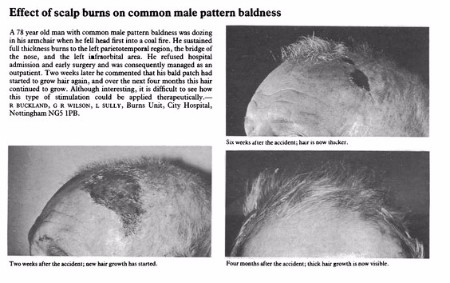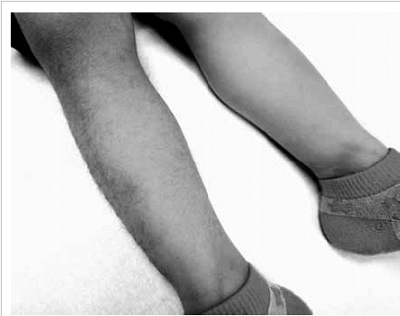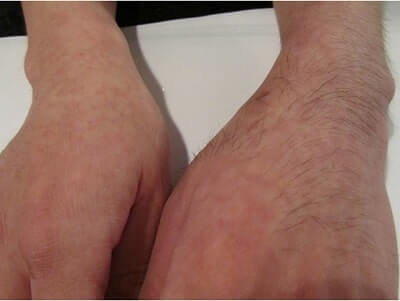Years ago, when I first heard about wounding induced hair growth, I was not entirely surprised. We have read numerous examples of older men re-growing hair (after accidents and injuries) in areas of the scalp that had been bald for decades. My favorite example is of the below 78-year old man who accidentally fell into a fire, burnt his scalp, and got hair growth in return.
“Although interesting, it is difficult to see how this type of stimulation could be applied therapeutically”.

Hair Growth After Cast Removal
My recent update on Follica made me think about the interesting phenomenon of hair growth after cast use. Many people who get arm or leg injuries have to use a plaster cast for several months. Upon removal of the cast, some people report a significant increase in the underlying body hair (i.e., hypertrichosis).
Today, I checked to see if there were any studies that discuss this unusual side effect from cast use. Lo and behold, I found some interesting ones with pretty extraordinary before and after photos. The below one is from a study from China titled: “Acquired Localized Hypertrichosis Induced by Internal Fixation and Plaster Cast Application”. The hands belong to a 15-year old boy who had to get a surgery and use a cast after a fracture.
The hair growth image in the actual study above is clearer, since I had to optimize the below image. The surprising thing is that this person has absolutely no hair at the back of the left hand. i.e., this is not just existing body hair becoming thicker. This is “new” hair growth after 6 weeks of cast use on the injured right hand. Kind of like Follica’s “de novo” hair creation concept. The new hair disappeared 4 months after the cast was removed.

Acquired Localized Hypertrichosis
It is not surprising that prolonged friction and enclosure from a plaster cast could make existing hair grow thicker. However, the creation of new hair is very unexpected. Yet another example below from Hong Kong shows hair growth on the right leg of a 28-month old child. That leg had been in a cast for 6 weeks after a fracture. Note that lack of any body hair on the left leg.

Per the authors of the first study that I discussed above, the acquired localized hypertrichosis (ALH) results from: “chronic irritation, inflammation, friction, and occlusion” by the plaster of Paris cast.
And yet another example from Hong Kong is even more striking. This time on the left forearm (of a 16-year old boy) that had been in a splint. Note again that there is no body hair at all on the right forearm. i.e., this person does not normally have hair on any arm.

If I only found examples of thicker hair growth, I would not have written this post. However, all three examples that I presented above show brand new localized hair growth.
Although this post is not exactly related to wounding, I can’t help but think of the following quote from Follica:
“Following skin disruption, cells that migrate to help healing are forced to make a decision: Should I make epidermis, or should I make a hair?“
Of course none of us would ever be indecisive given such a choice.
Has no one tried to put a plaster cast on their head?
There is no study in which a plaster is put on a healthy person and they check whether he will have hypertrichosis. After all, the first thing we need to know is the angiogenesis of tissues that occurs for healing leads to hair growth or the very fact of wearing plaster. It is important to say here that there are many medications, corticosteroids, procedures such as PUVA therapy, etc., which lead to hypertrichosis on the body, but do not have any effect on the scalp hair.
Now it’s very clear that the cure for brining NW-7/8 to NW-0 is by skin disruption with some topical compounds . The reason that Follica can’t achieve that YET is because there are some missing elements on their compound but at the time being they will deliver what they have and keep working on their miracle compound.
Thanks Admin for bringing these subjects and (reading between the lines)
they need to find a way to create a healing environment for the donor area after surgery so it can regrow the hairs like surgery never even happened. That will get around hair cloning for the time being. I think more companies need to look into regenerating donor hair after surgery. Alternative route/back up plan if hair cloning does not work.
This is just more cloning. How could “healing” ever replace a fully removed follicle? You might as well just create the new follicle at the recipient area and skip a step.
Very interesting post Admin! I wonder if this isn’t another indication that shallower wounding may be more effective than deeper wounding since the disruption in these cases is all at the surface…………….the Follica research says .8 mm and there is another study that says .6 mm is optimal.
https://www.fiercebiotech.com/biotech/biosplice-lays-off-41-drops-baldness-program-as-12b-valuation-confuses-everyone
Any word on Dr tsuji’s funding ?
Yes. It’s said Dr. Tsuji blew the lot on Hostess Bars, Mr. Miyagi socks and Pocky Sticks and was last seen living in a bat cave with squirrels…but now thinks he’s a chicken. Youngjet visits often to collect the eggs.
This is really interesting. It seems like even people with limited body hair (Asians, Native Americans etc) can grow hair after cast use.
I question whether that is truly follicular neogenesis. If examined under powered microscope, I would be surprised if tiny hair follicles were not observed on the untreated body part.
Well vellus hair are all over the body other than on the palms and soles and lips. So even conversion of vellus to terminal is incredible (since the vellus never converted to terminal in the uninjured limb).
https://www.youtube.com/watch?v=dLMU2JnGkDo
admin interview with Geoff Hamilton
Yes, Joe sent the Tweet yesterday:-) I just republished the post. Note that there will be 3 clips.
Yes. In fact hypertrichosis most frequently refers to elongation of vellus or intermediate type hair.
20+ years ago, a friend of mine was involved in a serious motorbike accident. I always remember when they took the plaster off one of his legs – thick, black hair, like a chimp. According to the nurse, it was very common. We still called him ape-boy though. Anyway, the hair did return to normal once out in the open.
I always assumed it was growth due to the opposite: lack of friction. By lying still, with the plaster covering his skin, in the warmth, the hair was free to grow thick. Normally, friction from movement and clothing would naturally pull out hairs and keep the growth tame. Because it was leg hair, vellus didn’t play much of a part in my thinking.
Very interesting. In the case of the Asian examples in this post, I am guessing that none of the limb hair would have turned terminal in their lives without this phenomenon. Native American examples would have been even more impressive, as it is hard for me to believe that they even have much vellus (transparent/invisible to the eye) body hair.
Knowing what I’m looking for now, I’d examine both of his legs under a microscope cam and see if I could figure out if it was a thickening of his normal leg hair or vellus turning terminal. I can’t imagine it’s hair from where there was simply none before, but without proof/evidence, I can’t make any real comments. Apparently, hair grows faster in the summer, so maybe it likes warmth? Everyone start wearing beanies year-round lol.
The leg photo is of a kid who is 28 months old (i.e., 2 years olf). Doubt he has any terminal hair at that age. In my eyes, vellus hair terminal or brand new hair creation is the same thing if the vellus hair was never going to turn terminal anyway.
As a related note, if CBD is turning vellus terminal, what would you imagine the process time would be? I know it’s impossible to know, but I’m sure I read somewhere about puberty, or some other study, where terminal took 8-10 months. Can’t find any details now. Same for grafts. Do you have any insights? Coming up to 8 months in my CBD self-experiment, and not sure how long to continue, and if it will continue to improve. I’m also not sure if vellus has turned terminal or just a thickening of thin hair. Definite improvement though, so that’s a plus.
I am not sure, but Minoxidil (topical and oral) can both do the same and there is still some uncertainty about how Minoxodil works:
https://www.hairlosscure2020.com/how-does-minoxidil-work/
On a related note, terminal hair that became vellus (due to balding) might be more amenable to covert back to terminal. Then you have the more difficult case of vellus that never becomes terminal (especially in certain genetic groups) and trying to make that happen. And then you have the third possibility that some humans do not even have any vellus (invisible) body hair. I do not think anyone ever tried to analyze such a situation, but maybe it is possible.
Thank you, Admin. I’ll read the article. I’m hoping vellus has turned terminal, but time will tell if hair appears where the follicles have died altogether. Optimistic, but realistic. Might only be acting as an anti-inflamatory and improving blood flow. Still good, but we’re looking for a full-on cure, ideally.
Also read this one where vellus turns terminal again for many transsexuals:
https://www.hairlosscure2020.com/male-to-female-mtf-transition-hair-growth/
Will do. Thanks!
Yes but is it any good if it goes away in 6 months? I just had an orif and was in a splint for a total of 1 month from the time of the fracture till the time of the splint removal. I was quite shocked to see that I have heavier darker hair on my arm, being a postmenopausal female I never thought I would see more hair growth except maybe on my face. As a matter of fact the hair on my lower legs has somewhat fallen out. So, sometimes this excessive darker hair growth resolves in less than 6 months. I mean I guess you could just keep irritating the skin over and over maybe like have a treatment of some kind that you go do every 3 months? It definitely needs some research. This could be the next gold mine breakthrough in hair loss treatment. Good luck everyone! P.S.- I’ll have to admit in my teens and twenties I didn’t find a bald man attractive but let me tell you once I went over the hill and hit 30 I really started to find baldness attractive. It’s just so masculine! Especially the male pattern baldness where it’s not just like thinning hair all over the head like an old lady with weak hair follicles. But I mean like the bald on top and hair on the sides the Dr Phil ball is what I call it: sexy! At this point I really got to say I actually prefer an older man who is bald to one that has a full head of hair especially if they have really thick hair and a low hairline that comes down their forehead too far like Valerie Bertinelli had in the ’70s and ’80s. I think somehow she must have had her hairline receded they can do that you know in plastic surgery if your hairline comes down too far on your forehead. Anyways yeah, I see that when I’m in a crowd I’m a single lady so, I see that when I’m in a crowd and I’m looking around my eyes usually almost always drawn to a man who has male pattern baldness. So maybe you shouldn’t be so fast to try and replace that hair that fell out.